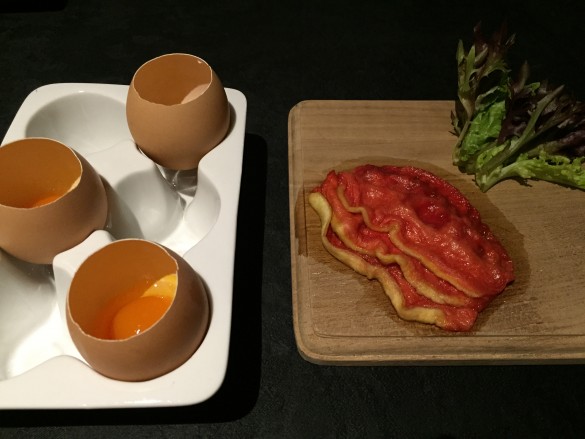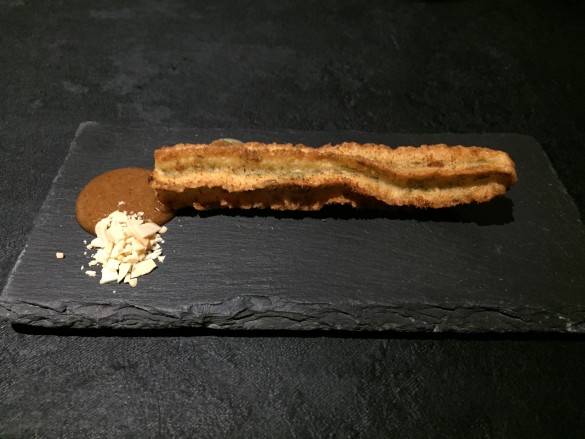Jakarta’s famed molecular gastronomy restaurant is a whole lot of style over substance.
Imagine if your teenaged son was gifted a large chemistry set one day, and decided after a few experiments that he wanted to open a restaurant. This is the thought that came to mind after sampling the 17-course degustation menu at Namaaz Dining. From beginning to end, I remained incredulous, and later aggrieved by the quality and value for one of Jakarta’s more expensive dining experiences. That this is Jakarta’s first molecular gastronomy restaurant is respectable, but the dining experience lacks demonstrable professionalism, substance and cohesion over the theatrics.
The mantra at Namaaz is ‘What you see is not what you get’. It was repeated several times over the evening – especially when a server either couldn’t or wouldn’t delve further into details over a dish when asked. Beyond the understanding of certain cultural and language cues, I found it rather bizarre the restaurant didn’t provide accompanying text for diners prior to the start of the meal, especially as some of the dishes had rather murky cultural references and a few of the dessert courses were obscured by audio-visual elements. I didn’t find it pleasant to ask multiple times over the speaker system blaring Justin Bieber just exactly what I was eating.
Service at Namaaz was discombobulating. The service staff seemed to be some of the same people preparing dishes in the open kitchen, and although a few extra bodies stood around to stare blankly through the dining room whilst trying to fill your water glasses for which they even struggled to maintain, they were hardly professional dining room wait staff. New cutlery was laid out before empty plates were taken away, and bits and crumbs were left glaringly out on display on the black tablecloth between each course.
Timing between courses went well overall, but when there are only three controlled seatings for a 28-head dining room each night, it should not be an issue. In a professional restaurant, the dining room could have been easily divided between two professional servers with four running staff and a couple of busboys. When a cockroach surprised us by climbing atop the table to join the meal at the beginning of the evening, one of the kitchen-service staff quickly removed it with a towel; the only problem was that after the incident, I kept wondering if she changed her gloves or towel when she served us a course.
Namaaz has one of the strangest drinks menus in town, which is to say, there isn’t one. There is not one juice or cocktail or wine or beer in sight. Seventeen courses and not a single pairing to enjoy. A corkage fee, usually reserved for restaurants as a way of discouraging diners from bringing their own wine when there is a bar or cellar full of well-paired drinks available, is collected at Namaaz. It is such a disservice to the diner when absolutely nothing is offered during a degustation menu. Some of the dishes could have benefited from beverages to counteract the intense salinity. Strong flavours do not require water to counteract; they require balance.
As for the food, out of 17 exhausting courses, there were only a few mildly pleasant dishes. That left the rest of the evening to suffer through a barrage of overambitious bites of food that was long on theatrics and very little on what really matters: whether the food tasted good. In this case, not much did.
For what some online reviews claim to be the number one restaurant in Jakarta, Namaaz is hardly a place to go for the food.
Perhaps under the pretence of theatre dining, the experience could be more forgiving. Other modernist restaurants I have had the pleasure of experiencing (one most notably, Alinea) have all the pomp and circumstance, but they are aligned with the food, and although innovative, at the core delicious. These restaurants take the diner on a celebratory experience with the basic assumption that although not all will understand it or the chef, most will appreciate eating there.
Chef Andrian Ishak does have the ambition and aptitude to work the basic techniques, but lacks the focus and detail to bring his creations to fruition. Behind all the smoke and mirrors, there are some huge, glaring cracks. Proudly self-taught, I wonder whether Chef Ishak would benefit from a stint staging at a modern dining establishment, which would hopefully elevate and open his horizons somewhat and where he can learn how these types of restaurants should operate.
A plate of what appeared to be a few slices of sukiyaki-style slices of raw beef paired with raw eggs served in their own shell, in actuality was dehydrated watermelon slices reconstituted in its own juices, served with a mango-passionfruit gelée. As one of the more playful dishes, its presentation was slightly askew as the watermelon juice seeped into an unappetizing wet puddle onto the wooden platter. A sad little lettuce leaf garnish did little to spruce up the platter.


The churro version of cakwe appeared good enough, but as soon as I bit into it, the tapioca starch created an experience akin to chewing a mouthful of old bubble gum that had been stuck under a desk a little too long. The sop buntut ‘afternoon tea’ was nearly inedible, with a stale ‘éclair’ filled with braised oxtail so bland that one had to dip it into the oversalted tea consisting of a broth with reconstituted vegetable and spice ‘tea bag’ that tasted eerily similar to instant Indomie purchased for Rp.2,000 at the local convenience store.
Two courses that did live up to its promise were the fish cake vermicelli, and smoked cassava and dried seafood sambal. The fish cake had a lightness and delicateness that tasted reminiscent of the ubiquitous sop bihun bakso ikan. The snail race presentation was interesting, but I failed to understand how it tied into the food. It was also difficult to eat as the edible spoon kept breaking apart when I tried to lift it to take a bite. Another course, the fried fish skin and smoked cassava with dried fish or shrimp sambal was delicious and the most inspired of the evening. The soft and starchy cassava paired with the crispy fish skin highlighted by the pungent sambal displayed wonderfully dark and black as saté charcoal.
I was left with the impression that although high on creativity, Namaaz Dining is still at best an amateur’s approach to molecular gastronomy with years of development and professional restaurant mastery to attain. For the price and length of time dedicated to its 17 courses, there are much better restaurants in Jakarta to consider.
The Critic’s Verdict?
1 out of 5 stars
Namaaz Dining
Jalan Gunawarman no. 42, Jakarta 12110
Website: www.namaazdining.com
Online reservations only
Price per diner: Rp.1,250,000/prepay in full when you book your reservation
No beverages except water available, BYO with corkage fee






